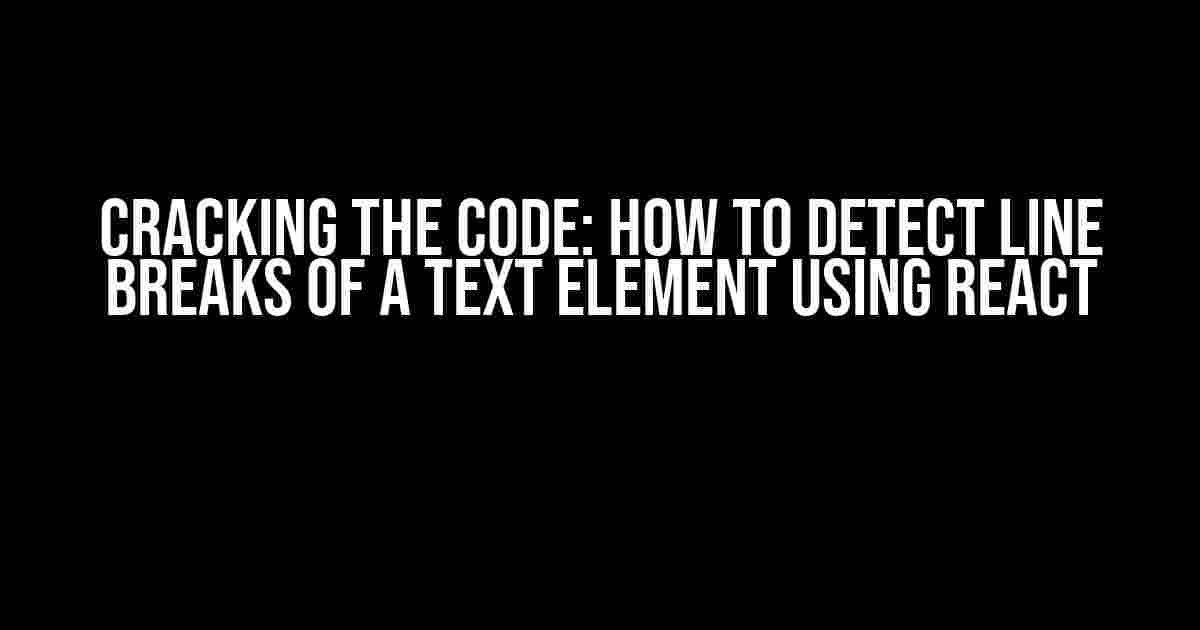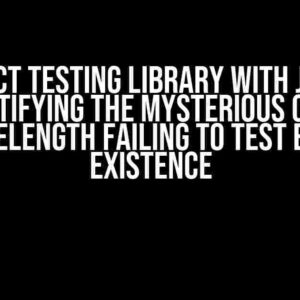Are you tired of struggling with pesky line breaks in your React application? Do you find yourself wondering, “How can I detect line breaks of a text element using React?” Fear not, dear developer, for we’re about to embark on a journey to demystify this conundrum and uncover the secrets to mastering line break detection in React.
The Problem: Unseen Line Breaks
In React, when working with text elements, it’s not uncommon to encounter line breaks that seem to appear out of nowhere. These invisible line breaks can cause frustration and confusion, especially when trying to style or manipulate the text. But, why do they occur in the first place?
The culprit behind these unseen line breaks is often the way React handles whitespaces. By default, React ignores whitespace characters, including line breaks, when rendering text elements. This means that even though you may see line breaks in your code, they won’t be reflected in the rendered output.
Solution 1: The White Space Preserving Approach
One approach to detecting line breaks is to use the `white-space` CSS property to preserve whitespace characters, including line breaks. By setting `white-space` to `pre` or `pre-wrap`, you can ensure that React renders the text element with the exact whitespace characters, including line breaks.
<div style={{ whiteSpace: 'pre' }}>
{text}
</div>
While this approach works, it has its limitations. For instance, it can affect the layout and styling of your component, and might not be suitable for all use cases.
Solution 2: The Regular Expression Route
Another approach is to use regular expressions to detect line breaks in the text element. By using a regex pattern that matches line breaks, you can extract the line breaks and handle them accordingly.
const text = 'This is a sample text\nwith multiple line breaks.';
const lineBreakRegex = /\r\n|\n|\r/g;
const lineBreaks = text.match(lineBreakRegex);
if (lineBreaks) {
console.log(`Line breaks found: ${lineBreaks.length}`);
} else {
console.log('No line breaks found.');
}
This approach provides more control over the detection of line breaks, but it can become cumbersome when dealing with complex text elements or large datasets.
Solution 3: The DOM Inspection Method
A more robust approach is to inspect the DOM element directly to detect line breaks. By using the `offsetTop` property of the text element, you can determine if a line break exists.
const textElement = document.getElementById('text-element');
const lineBreaks = [];
for (let i = 0; i < textElement.childNodes.length; i++) {
const node = textElement.childNodes[i];
if (node.nodeType === 3) {
const text = node.textContent;
const rects = Array.prototype.slice.call(node.getClientRects());
for (let j = 0; j < rects.length; j++) {
const rect = rects[j];
if (rect.top !== rects[0].top) {
lineBreaks.push(rect.top);
}
}
}
}
console.log(`Line breaks found: ${lineBreaks.length}`);
This method is more accurate and provides a clear indication of where line breaks occur, but it can be resource-intensive and may not be suitable for high-performance applications.
Solution 4: The React Hooks Approach
In React, you can use hooks to detect line breaks in a more elegant and efficient manner. By creating a custom hook that utilizes the `useLayoutEffect` hook, you can detect line breaks without affecting the performance of your application.
import { useLayoutEffect, useState } from 'react';
const useLineBreaks = (text) => {
const [lineBreaks, setLineBreaks] = useState([]);
useLayoutEffect(() => {
const textElement = document.getElementById('text-element');
const lineBreaks = [];
for (let i = 0; i < textElement.childNodes.length; i++) {
const node = textElement.childNodes[i];
if (node.nodeType === 3) {
const text = node.textContent;
const rects = Array.prototype.slice.call(node.getClientRects());
for (let j = 0; j < rects.length; j++) {
const rect = rects[j];
if (rect.top !== rects[0].top) {
lineBreaks.push(rect.top);
}
}
}
}
setLineBreaks(lineBreaks);
}, [text]);
return lineBreaks;
};
const text = 'This is a sample text\nwith multiple line breaks.';
const lineBreaks = useLineBreaks(text);
console.log(`Line breaks found: ${lineBreaks.length}`);
This approach provides a clean and efficient way to detect line breaks in React, making it an ideal solution for most use cases.
Conclusion
Detecting line breaks in a text element using React can be a challenge, but with the right approaches, you can overcome this hurdle. Whether you choose to use the white space preserving approach, regular expression route, DOM inspection method, or React hooks approach, you’ll be well on your way to mastering line break detection in React.
Remember, when working with text elements, it’s essential to consider the implications of line breaks on your application’s layout, styling, and performance. By choosing the right solution for your use case, you can ensure a seamless user experience and take your React skills to the next level.
| Solution | Description | Pros | Cons |
|---|---|---|---|
| White Space Preserving Approach | Preserves whitespace characters, including line breaks | Easy to implement, affects layout and styling | Might not be suitable for all use cases |
| Regular Expression Route | Uses regex pattern to detect line breaks | Provides control over line break detection, can be cumbersome | May not work for complex text elements or large datasets |
| DOM Inspection Method | Inspects DOM element to detect line breaks | Accurate, provides clear indication of line breaks | Resource-intensive, may not be suitable for high-performance apps |
| React Hooks Approach | Uses custom hook to detect line breaks | Elegant, efficient, and scalable | Requires React Hooks knowledge |
Best Practices
- Always consider the implications of line breaks on your application’s layout, styling, and performance.
- Choose the solution that best fits your use case and requirements.
- Test and debug your implementation to ensure it works as expected.
- Document your implementation for future reference and maintenance.
By following these best practices and mastering the art of line break detection in React, you’ll be well on your way to creating robust, scalable, and maintainable applications that delight users and impress colleagues alike.
Frequently Asked Questions
-
Q: Why do line breaks appear in my text element?
A: Line breaks can appear due to the way React handles whitespaces. By default, React ignores whitespace characters, including line breaks, when rendering text elements.
-
Q: Can I use CSS to detect line breaks?
A: While CSS can be used to style text elements, it’s not suitable for detecting line breaks. CSS is primarily used for presentation, not for detecting semantic changes in the DOM.
-
Q: What’s the best approach for detecting line breaks in React?
A: The best approach depends on your specific use case and requirements. However, the React Hooks approach is often the most elegant and efficient solution.
We hope this comprehensive guide has helped you crack the code on detecting line breaks in React. Remember, with great power comes great responsibility, so use your newfound knowledge wisely and create amazing React applications that inspire and delight!
Here is the response:
Frequently Asked Question
Get ready to conquer the world of React and learn how to detect line breaks of a text element like a pro!
Q1: How do I detect line breaks in a text element using React?
You can use the `split()` method to split the text into an array of lines. For example: `const lines = myText.split(‘\n’);`. This will give you an array of strings, where each string represents a line of text.
Q2: What if I want to preserve the line breaks when rendering the text element?
You can use the `-dangerouslySetInnerHTML` prop in React to preserve the line breaks. For example: `
‘) }} />`. This will replace each line break with a `` tag, preserving the original line breaks.
Q3: Can I use a CSS solution to detect line breaks?
Yes, you can use CSS to detect line breaks by setting the `white-space` property to `pre-wrap`. For example: `
`. This will preserve the line breaks and wrap the text to the next line.
Q4: How do I count the number of line breaks in a text element?
You can use the `split()` method to split the text into an array of lines, and then use the `length` property to count the number of lines. For example: `const lineCount = myText.split(‘\n’).length;`. This will give you the number of line breaks in the text.
Q5: Can I detect line breaks in a React stateless functional component?
Yes, you can detect line breaks in a React stateless functional component using the same methods as in a class component. For example, you can use the `split()` method or CSS to detect and preserve line breaks in a text element.






